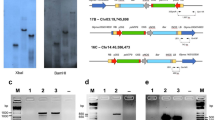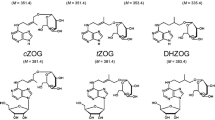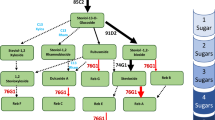Abstract
We cloned and sequenced a rat cDNA encoding the 2′-5′ oligoadenylate synthetase, a component of the mammalian interferon-induced antiviral response, and used Agrobacterium-mediated transformation to generate transgenic potato clones expressing this mammalian enzyme. In transgenic plants infected with potato virus X and followed under field conditions, virus concentrations in leaves and in tubers were significantly lower than in nontransgenic controls. Additionally, virus concentration in the leaves of five transgenic clones and in tubers of one clone was also lower than in transgenic potatoes expressing potato virus X coat protein.
This is a preview of subscription content, access via your institution
Access options
Subscribe to this journal
Receive 12 print issues and online access
$209.00 per year
only $17.42 per issue
Buy this article
- Purchase on Springer Link
- Instant access to full article PDF
Prices may be subject to local taxes which are calculated during checkout
Similar content being viewed by others
References
Gadani, F., Mansky, L.M., Medici, R., Miller, W.A. and Hill, J.H. 1990. Genetic engineering of plants for virus resistance. Arch. Virol. 115: 1–21.
Beachy, R.N., Loesch-Fries, S. and Tumer, N. 1990. Coat protein-mediated resistance against virus infection. Annu. Rev. Phytopathol. 28: 451–474.
Hull, R. and Davies, J.W. 1992. Approaches to nonconventional control of plant virus diseases. Crit. Rev. Plant Sci. 11: 17–33.
Neijdat, A., Clark, W.G. and Beachy, R.N. 1990. Engineered resistance against plant virus diseases. Physiol. Plant. 80: 662–668.
Stark, D.M. and Beachy, R.N. 1989. Protection against potyvirus infection in transgenic plants. Evidence for broad spectrum resistance. Bio/Technology 7: 1257–1262.
Ling, K., Namba, S. and Gonsalves, D. 1991. Protection against detrimental effects of potyvirus infection in transgenic tobacco plants expressing the papaya ringspot virus coat protein gene. Bio/Technology 9: 752–758.
Lengyel, P. 1982. Biochemistry of interferons and their action. Annu. Rev. Biochem. 51: 251–282.
Samuel, C.E. 1991. Antiviral actions of interferon. Interferon-regulated cellular proteins and their surprisingly selective antiviral activities. Virology 183: 1–11.
Nilsen, T.W., Maroney, P.A., Robertson, H.D. and Baglioni, C. 1982. Heterogeneous nuclear RNA promotes synthesis of (2′,5′)oligoadenylate and is cleaved by the (2′.5′)oligo-adenylate-activated endoribonuclease. Mol. Cell. Biol. 2: 154–160.
Sela, I. 1981. Plant-virus interactions related to resistance and localization of viral infections. Adv. Virus Res. 26: 201–237.
Devash, Y., Hauschner, A., Sela, I. and Chakraburtty, K. 1981. The antiviral factor (AVF) from virus-infected plants induces discharge of histidnyl-TMV-RNA. Virology 111: 103–112.
Reichman, M., Devash, Y., Suhadolnik, R.J. and Sela, I. 1983. Human leukocyte interferon and the antiviral factor (AVF) from virus-infected plants stimulate plant tissues to produce nucleotides with antiviral activity. Virology 128: 240–244.
Devash, Y., Reichman, M., Sela, I., Reichenbach, N.L. and Suhadolnik, R.J. 1985. Plant oligoadenylates: enzymatic synthesis, isolation, and biological activities. Biochemistry 24: 593–599.
Devash, Y., Sela, I. and Suhadolnik, R.J. 1986. Enzymatic synthesis of plant oligo-adenylates in vitro. Meth. Enz. 119: 752–758.
Devash, Y., Biggs, S. and Sela, I. 1982. Multiplication of tobacco mosaic virus in tobacco leaf disks is inhibited by (2′-5′) oligoadenylate. Science 216: 1415–1416.
Devash, Y., Gera, A., Willis, D.H., Reichman, M., Pfleiderer, W., Charubala, R., Sela, I. and Suhadolnik, R.J. 1984. 5′-dephosphorylated 2′,5′-adenylate trimer and its analogs. Inhibition of tobacco mosaic virus replication in tobacco mosaic virus-infected leaf discs, protoplasts, and intact tobacco plants. J. Biol. Chem. 259: 3482–3486.
Devash, Y., Suhadolnik, R.J. and Sela, I. 1986. Measurement of effect of (2′-5′)-oligo-adenylates and analogs on tobacco mosaic virus replication. Meth. Enz. 119: 759–761.
Sela, I., Grafi, G., Sher, N., Edelbaum, O., Yagev, H. and Gerassi, E. 1987. Resistance systems related to the N gene and their comparison with interferon. p. 109–119. In: Plant Resistance to Viruses. Ciba Foundation symposium 133. D. Evered and S. Harnett (Eds.). John Wiley & Sons, Chichester, UK.
Babosha, A.V., Trofimets, L.N. and Ladygina, M.E. 1990. Oligoadenylates and oligoadenylate synthetase of potato plants in protective reactions, against virus pathogen. Dokl. Akad. Nauk SSSR 313: 252–255 (in Russian).
Ichii, Y., Fukunaga, R., Shiojiri, S. and Sokawa, Y. 1986. Mouse 2-5A synthetase cDNA: nucleotide sequence and comparison to human 2-5A synthetase. Nucleic Acids Res. 14: 100–117.
Coccia, E.M., Romeo, G., Nissim, A., Marziali, G., Albertini, R., Affabris, E., Battistini, A., Fiorucci, G., Orsatti, R., Rossi, G.B. and Chebath, J. 1990. A full-length murine 2-5A synthetase cDNA transfected in NIH-3T3 cells impairs EMCV but not VSV replication. Virology 179: 228–233.
Pearson, W.R. and Lipman, D.J. 1988. Improved tools for biological sequence comparison. Proc. Natl. Acad. Sci. USA 85: 2444–2448.
Helariutta, Y., Elomaa, P., Kotilainen, M., Seppanen, P. and Teeri, T.H. 1993. Cloning of cDNA coding for dihydroflavonol-4-reductase (DFR) and characterization of dfr expression in corrollas of Gerbera hybrida var. Regina (Compositae). Plant. Mol. Biol. 22: 183–193.
Horsch, R.B., Fry, J.E., Hoffmann, N.L., Eichholtz, D., Rogers, S.G. and Fraley, R.T. 1985. A simple and general method for transferring genes into plants. Science 227: 1229–1231.
Beemster, A.B.R. and de Bokx, J.A. 1987. Survey of properties and symptoms, p. 84–114. In: Viruses of Potatoes and Seed-Potato Production, 2nd ed. J. A. de Bokx and J. P. H. van der Want (Eds.). Pudoc, Wageningen, Netherlands.
Murashige, T. and Skoog, F. 1962. A revised medium for rapid growth and bioassays with tobacco tissue cultures. Physiologia Plantarum 15: 473–497.
Skryabin, K.G., Kraev, A.S., Morozov, S., Yu Rozanov, M.N., Chernov, B.K., Lukasheva, L.I. and Atabekov, J.G. 1988. The nucleotide sequence of potato virus X RNA. Nucleic Acids Res. 16: 10929–10930.
Mehto, M. 1991. Penman X-virukselle resistentin Pito-lajikkeen aikaan-saaminen viruksen vaippaproteiinigeenin siirrolla. M.Sc. thesis, Department of Genetics, University of Oulu.
Sambrook, J., Fritsch, E.T. and Maniatis, T. 1989. Molecular Cloning: A Laboratory Manual, 2nd ed. Cold Spring Harbour Laboratory Press, N.Y.
Huynh, T.V., Young, R.A. and Davis, R.W. 1984. Constructing and screening cDNA libraries in λgt10 and λgt11, p. 49–78. In: DNA Cloning: A Practical Approach. D. M. Glover (Ed.). IRL Press, Oxford, UK.
Feinberg, A.P. and Vogelstein, B. 1983. A technique for radiolabeling DNA restriction endonuclease fragments to high specific activity. Anal. Biochem. 132: 6–13.
Sanger, F., Nicklen, S. and Coulson, A.R. 1977. DNA sequencing with chain-terminating inhibitors. Proc. Natl. Acad. Sci. USA 74: 5463–5467.
Van Haute, E., Joos, H., Maes, M., Warren, G., Van Montagu, M. and Schell, J. 1983. Intergeneric transfer and exchange recombination of restriction fragments cloned in pBR 322: a novel strategy for the reversed genetics of the Ti plasmids of Agrobacterium tumefaciem. EMBO J. 2: 411–417.
Dhaese, P., De Greve, H., Decraemer, H., Schell, J. and Van Montagu, M. 1979. Rapid mapping of transposon insertion and deletion mutations in the large Ti-plasmids of Agrobacterium tumefaciens. Nucleic Acids Res. 7: 1837–1849.
Jones, J.D.C., Dunsmuir, P. and Bedbrook, J. 1985. High level expression of introduced chimeric genes in regenerated transformed plants. EMBO J. 4: 2411–2418.
Doyle, J.J. and Doyle, J.L. 1990. Isolation of plant DNA from fresh tissue. Focus 12: 13–15.
Chirgwin, J.M., Przybyla, A.E., MacDonald, R.J. and Rutter, W.J. 1979. Isolation of biologically active ribonucleic acid from sources enriched in ribo-nuclease. Biochemistry 18: 5294–5299.
Teeri, T., Kumar, V., Lehtovaara, P. and Knowles, J. 1987. Construction of cDNA libraries by blunt end ligation: high frequency cloning of long cDNAs from filamentous fungi. Anal. Biochem. 164: 60–67.
Gugerli, P. and Gehringer, W. 1981. Enzyme-linked immunosorbent assay (ELISA) for the detection of potato leafroll virus and potato virus Y in potato tubers after artificial break of dormancy. Pot. Res. 23: 353–359.
Clark, M.F. and Adams, A.N. 1977. Characteristics of the microplate method of enzyme-linked immunosorbent assay for detection of plant viruses. J. Gen. Virol. 34: 475–483.
Casper, R. and Meyer, S. 1981. Die Anwendung des ELISA-Verfahrens zum Nachweis pflanzenpathogener Viren. Nachrichtenbl. Deut. Pflanzenschutzd. 33: 49–54.
Author information
Authors and Affiliations
Rights and permissions
About this article
Cite this article
Truve, E., Aaspôllu, A., Honkanen, J. et al. Transgenic Potato Plants Expressing Mammalian 2′–5′ Oligoadenylate Synthetase are Protected From Potato Virus X Infection Under Field Conditions. Nat Biotechnol 11, 1048–1052 (1993). https://doi.org/10.1038/nbt0993-1048
Received:
Accepted:
Issue Date:
DOI: https://doi.org/10.1038/nbt0993-1048
This article is cited by
-
Recent developments in our knowledge of potato transgenic biology
Potato Research (1996)
-
Expression of Mammalian Antiviral Enzymes from the 2–5A System in Transgenic Plants
Journal of Plant Biochemistry and Biotechnology (1996)
-
Strategies for engineering virus resistance in transgenic plants
Euphytica (1995)



